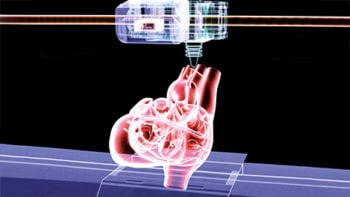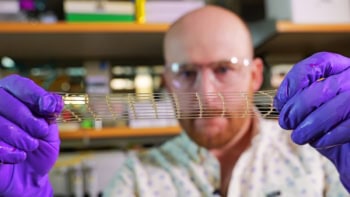
Researchers in Russia, Latvia and the US have developed a scaffold-, label- and nozzle-free technology that can fabricate complex human tissue and organs within just 30 seconds. The formative “scaffield” approach, as they have dubbed it, exploits magnetic levitation to produce 3D constructs, rather than the traditional layer-by-layer bioprinting approach, and the researchers believe it could be used in the microgravity conditions of space (Biofabrication 10 034104)
The technique relies on the use of tissue spheroids, densely packed aggregates of living cells that can be used as building blocks for bioprinting functional human tissues and organs. Tissue spheroids offer the highest possible theoretical cell density, comparable with natural tissue, while their compact round shape makes them easy to handle and process.
Tissue spheroids also have a complex internal structure and multicellular composition, and can even be pre-vascularized. When placed closely together so ther are directly touching, they can fuse to produce complex 3D tissue constructs – which is how tissue fusion occurs during natural embryonic development.
“We believe that this scaffold-free approach is a new direction in ‘formative’ biofabrication”
Vladimir Mironov, Laboratory for Biotechnological Research
Several techniques are available to fabricate tissue and organs using tissue spheroids, but all rely on 3D scaffolds, nozzles and biolabels. One method, for example, requires cell aggregates to be placed into 3D scaffolds made from various biodegradable materials, while another involves attaching and spreading tissue spheroids on electrospun matrices. And, although researchers routinely use magnetic forces to create 2D patterns of tissue spheroids biofabricated from cells, these cells first need to labelled with magnetic nanoparticles.
The new technique, developed a by team of researchers led by Vladimir Mironov of the Laboratory for Biotechnological Research “3D Bioprinting Solutions” in Moscow and Utkan Demirci of Stanford University, instead exploits magnetic levitation to assemble the tissue spheroids into a 3D structure. It therefore avoids the need for any scaffolds or labelling, and it also works without traditional nozzle-based bioprinters.
Magnetic attraction
Magnetic levitation of living material was first demonstrated at the end of the 20th century. In these pioneering studies, researchers guided the assembly of small magnetic objects suspended in a paramagnetic fluid medium that was positioned in a magnetic field gradient generated by strong permanent magnets.
In these experiments, gadolinium particles (Gd3+) were used to paramagnetize the media in which the objects were suspended. These particles have already been approved by the US Food and Drug Administration (FDA) for use as contrast agents in magnetic resonance imaging, so are safe in low concentrations.
Early experiments by Mironov and Demirci’s team confirmed that relatively weak magnetic fields could successfully levitate and assemble tissue spheroids taken from primary sheep chondrocytes. However, these procedures only worked in the presence of high levels, and thus toxic concentrations, of Gd3+. In their new work, they have used higher magnetic field gradients of up to 2.2 Tesla/cm to overcome this problem, which ensures that the concentration of Gd3+does not exceed 250 mM.
Demirci explains that the technique can be used to manipulate and assemble millions of cells, making it possible to create a 3D biological contruct and then connect these constructs together. “Instead of synthetic or natural scaffolds, we have used a magnetic field as a temporal and removable support,” adds Mironov.
“We believe that this scaffold-free approach is a new direction in ‘formative’ biofabrication,” Mironov told Physics World. “We envision that it will allow us to fabricate complex human tissue constructs and organ models extremely quickly compared to traditional layer-by-layer ‘additive’ biofabrication.”
The researchers are now working on magnetic levitational assembly using high magnetic fields in the microgravity conditions of space. “This will allow for rapid assembly of 3D tissue constructs from tissue spheroids with the minimal concentration of paramagnetic Gd3+,” explains Mironov. “Another possible and interesting route to try might be a hybrid approach that combines both magnetic levitational assembly and acoustic levitational assembly, and Demirci’s team has already shown that acoustic fields can be used to produce 3D biofabricated constructs using live cells.”
- Read our special collection “Frontiers in biofabrication” to learn more about the latest advances in tissue engineering. This article is one of a series of reports highlighting high-impact research published in Biofabrication.



